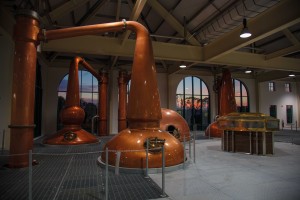Tullamore D.E.W. distillery
Published in Editorial, Issue 6 (November/December 2014), Volume 22
The new distillery features four handcrafted copper stills, modelled on the original pre-1954 Tullamore stills. (Jeff Harvey)
The Scottish owner of the Tullamore D.E.W. brand, William Grant & Sons, opened the first new Irish distillery on a greenfield site in over 100 years on 17 September 2014 at a cost of ?35 million. Tullamore D.E.W. is now the second biggest Irish whiskey brand after Jameson and employs 90 people at its locations in Clonmel, Dublin and Tullamore. According to Minister Simon Coveney, who performed the opening ceremony, the outlook for Irish whiskey in export markets is very favourable. Since 2000 the Irish distilling industry has been going through a renaissance, with the completion of major new projects for Irish Distillers at Midleton, now at Tullamore, and others in progress at Carlow, the Dublin Liberties and elsewhere.
The distilling industry is notoriously cyclical in nature, with no less than 1,200 cottage industry-type stills in the 1780s reducing to 40 by the time of new legislation in 1823. The new act led to expansion in the business, only for this to be curtailed by Fr Mathew’s temperance campaign in the 1830s combined with economic depression in the 1840s. The business expanded again from the 1860s to the first decade of the 1900s. The Lloyd George budget of 1909–10 and the increases thereafter in the spirit duty depressed demand, exacerbated by the collapse of export markets with the advent of prohibition in the United States in the 1920s.
The new Tullamore distillery will give Grant’s control over its own whiskey supply. Currently, it sources whiskey for Tullamore D.E.W. from rivals, including the Pernod Ricard subsidiary, Irish Distillers. The new distillery sources its water from the nearby Slieve Bloom Mountains and will be capable of producing the equivalent of 1.5 million cases of Tullamore D.E.W. annually when fully operational. This distillery features four handcrafted copper stills (modelled on the original Tullamore stills), six brew-house fermenters, each with a 34,000-litre capacity, and warehouse space for 100,000 casks. It will be three years before the spirit being produced at Tullamore can be termed whiskey under current law.
Tullamore D.E.W never died as a product, but when the distillery ceased production in 1954 it did seem to Tullamore people as if that was the end of an association with distilling going back to the founding of the Tullamore Distillery in 1829. The question of reopening the distillery was considered in the 1960s, but the idea was abandoned; the brand name was sold to Power’s in 1965 and soon after was incorporated into the Irish Distillers Group. The brand was sold to C&C in 1993 and to Grant’s in 2010 for ?171 million.
The original owner of the Tullamore distillery was Michael Molloy, and some of his family were in the wine and spirit business in Tullamore in the early 1800s. The helpful legislation of 1823 allowed the industry to develop and Molloy founded the distillery on the same site as an earlier one operated by Joseph Flanagan. Molloy devoted some of his profits to helping found the Mercy convent and schools in Tullamore in the late 1830s. His nephew, Bernard Daly, inherited the distillery in the 1840s, and in the 1870s or early 1880s appointed Daniel E. Williams as the general manager. Both Daly and his son, also Bernard, became part of the minor gentry set in the district, and by the 1900s Williams had control of the distillery.
Daniel E. Williams, born in 1848, came to work in Tullamore from nearby Quaker-dominated Mountmellick in the mid-1860s and by hard work raised himself from a mill-hand/machine operative to distiller and general manager. It was from the 1860s that the distillery was greatly improved, with new buildings and new machinery. Although the chief distiller, Williams also opened his first pub-grocery in Patrick Street, Tullamore, in 1884 and by the early 1900s had more than twenty shops, together with a wholesale, malting and wine and spirit business. It was a lesson in convergence and sticking to what you do best.
Williams was soon the richest man in Tullamore, with a fine house known as Dew Park on the road to Charleville Demesne. Some, including envious Belfast blenders, said that he brought the whiskey from the distillery through a hidden water-pipe under Patrick Street to his whiskey stores near the bonded warehouse, but despite searches by suspicious excise men no whiskey-filled pipe was ever found. The story became a legend with, not surprisingly, a great number of variants and yarns, such as that somebody used to sing outside the head office in Patrick Street ‘O Danny boy, the pipes are calling’.
The Tullamore Dew brand was established in the 1890s and was sold in bulk and in bottle across the world since then. To emphasise the contribution of Daniel E. Williams, the product name was changed by Grant’s to ‘Tullamore D.E.W.’ after 2010. A visitor centre was opened in 2000 and revamped in 2012 at a cost of ?2 million; it now attracts 25,000 visitors annually.
Michael Byrne is secretary of Offaly Historical and Archaeological Society and author of Legal Offaly (2008) and Tullamore: a portrait (2010).


















